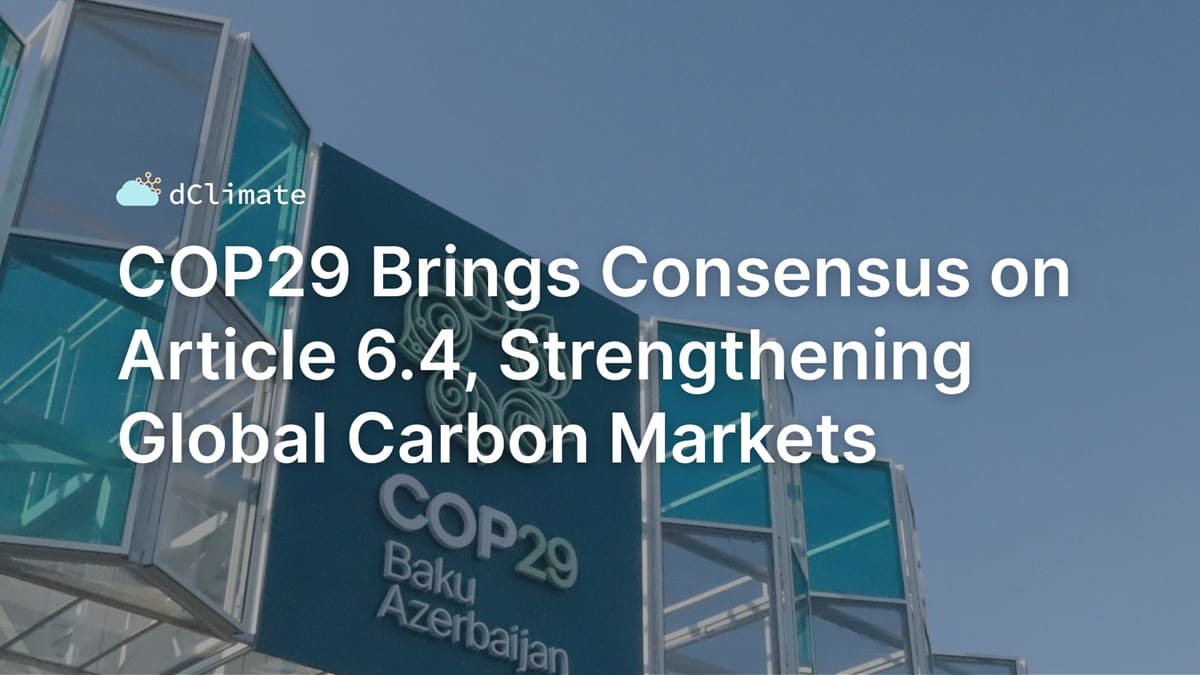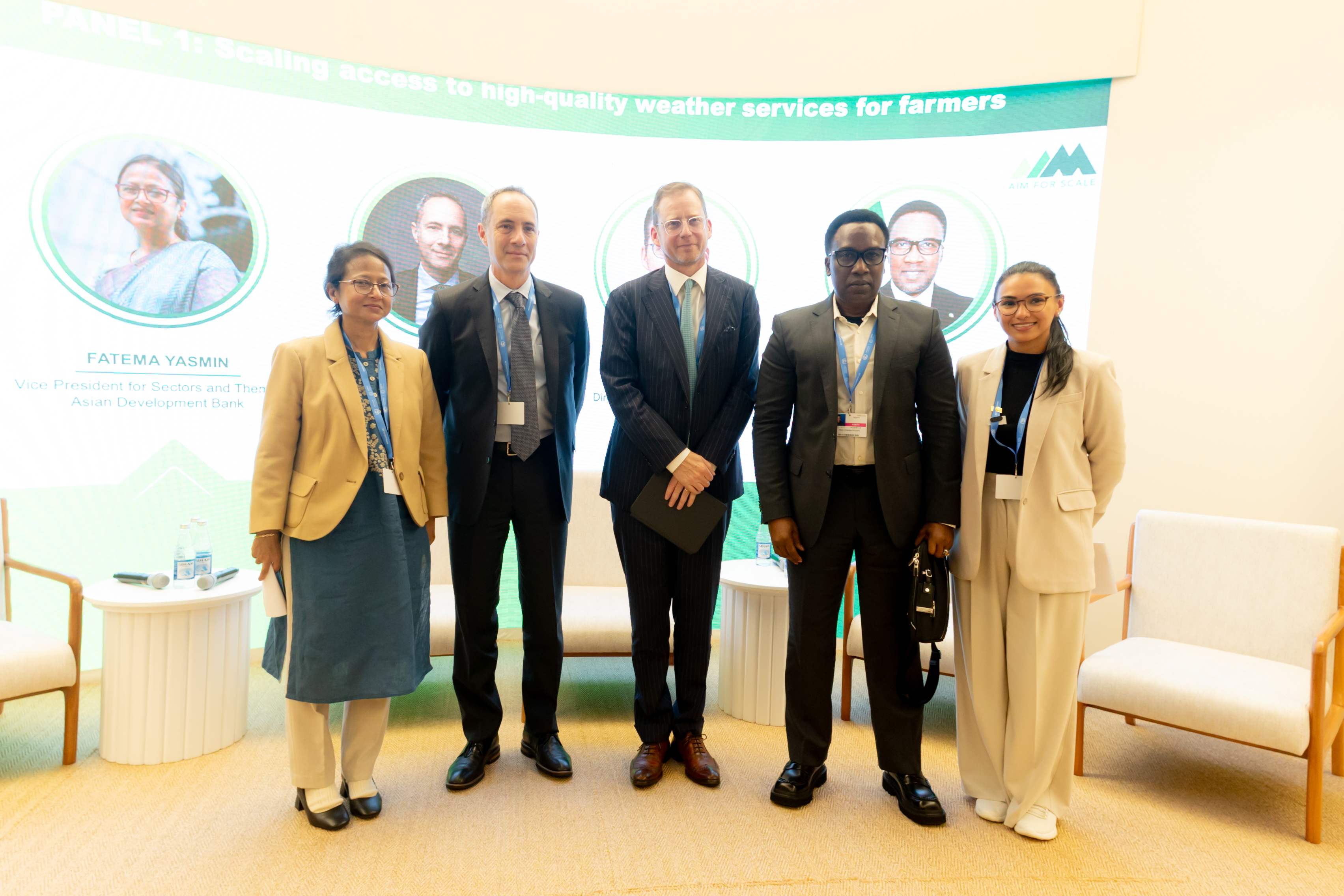Data ReFined #44: COP29 Brings Consensus on Article 6.4, Strengthening Global Carbon Markets

⛅ Data ReFined is dClimate's biweekly newsletter, delivering the latest insights on carbon finance in the voluntary carbon market (VCM), climate risk management, and climate intelligence.
In this edition:
Carbon Finance & Digital MRV
🌳 COP29's Consensus on Article 6.4 Standards Improves Carbon Market Integrity
🌳 Forest Loss in Brazil’s Amazon Reduced by Almost a Third
🌳 Funding Forest Preservation Through Carbon Credits
Climate Risk Management
🛡️ How Parametric Insurance Pricing Works
🛡️ Over $2 Trillion in Damages from Climate-Related Risks and Extreme Weather
🛡️ Leveraging AI for Climate Risk Management
🛡️ 2024 'Virtually Certain' to be 1.5ºC Above Pre-Industrial Levels
Climate Data & Intelligence
🌎 Improving Access to Weather Data for Farmers in the Global South
🌎 NASA's Earth Science Data Roundup
🌎 New Satellite Data from NASA and ISRO
Scroll down for our summaries of this news! 👇
Subscribe here and join over 4000+ readers!

COP29's Consensus on Article 6.4 Standards Improves Global Carbon Market Integrity
At COP29 in Baku, a breakthrough was made on global carbon markets, with country representatives reaching a consensus on key standards for carbon credits under Article 6.4. These standards reshape international carbon trading through more transparency and high-integrity credits, increasing global market participation.
For more information, please refer to the full article on the COP29 website:
Dive deeper into the implications of Article 6.4 by reading this in-depth explainer article published by The Banker, providing more context and nuance.
Forest Loss in Brazil’s Amazon Reduced by Almost a Third
Brazil has reported a 30.6% reduction in Amazon deforestation over the last year, marking the lowest rate in nearly a decade. This progress aligns with COP29's emphasis on leveraging high-integrity carbon markets to fund conservation initiatives like Brazil's forest preservation efforts. Read more
Digital MRV platforms such as CYCLOPS are pioneering new ways of monitoring forests, offering reliable data to support carbon issuers and improve the credibility of carbon markets.
Funding Forest Preservation Through Carbon Credits
At COP29, urgent calls are being made for concrete action on forest conservation, with high-integrity carbon markets and robust regulatory frameworks seen as essential for protecting and restoring forests. Read more

How Parametric Insurance Pricing Works
Arbol’s recent blogpost explains the pricing dynamics of climate-related parametric insurance solutions, such as using climate data, AI, and preset triggers to automatically process payouts and streamlining claims.
Find more detailed insights via the link below:

Over $2 Trillion in Damages from Climate-Related Risks and Extreme Weather Events
A report commissioned by the International Chamber of Commerce analyzed 4,000 extreme weather events between 2014 and 2023, concluding that the global economy suffered $2 trillion in damage from climate perils over the past decade. According to the study, the United States has experienced the hardest economic hit. Read more
Leveraging AI for Climate Risk Management
A recent survey by ZestyAI shows growing AI adoption in insurance for extreme weather risk management, with insurtechs and reinsurers leading the way. Traditional actuarial, stochastic, and AI-driven models vary in use based on the type of climate risk, with hybrid model approaches gaining traction. Read more
2024 'Virtually Certain' to be 1.5ºC Above Pre-Industrial Levels
According to Copernicus' ERA5 dataset, 2024 is almost certain to become the hottest year on record, with average global temperatures exceeding 1.5ºC above pre-industrial levels. October 2024 alone saw several notable climate impacts, such as record-low Antarctic sea ice levels as well as severe flooding in Spain, Italy, Australia, and other regions. Read more

Improving Access to Weather Data for Farmers in the Global South
At COP29, the AIM for Scale initiative introduced a $1 billion project to deliver AI-driven weather forecasting to farmers across Asia, Africa, and Latin America. With support from the WMO and the World Bank, the global partnership focuses on strengthening resilience by providing localized, data-driven climate insights to aid farmers in adapting to climate challenges.
Read the full article for more details:

In related news, the WMO recently published a report on the State of Climate Services, highlighting the need for reliable and accessible climate information.
NASA's Earth Science Data Roundup
NASA released an October 2024 update featuring 17 newly added or updated datasets and resources, further expanding Earth observation data to support climate research, environmental monitoring, and climate tech solutions. Read more
New Satellite Data from NASA and ISRO
The upcoming NISAR satellite, set for launch in 2025, will map global surface changes with high precision. Using dual radar systems, NISAR will monitor land and ice movements across the globe every 12 days, aiding in the detection of earthquakes, volcanic activity, and landslide risks. Read more
Thank You For Reading Our Newsletter! 💙
We greatly appreciate your interest and support! If you enjoyed this newsletter, please consider forwarding it to your network to increase awareness of these critical climate topics.
About dClimate
dClimate’s decentralized and open climate data infrastructure powers a wide range of applications, including climate risk assessments, parametric insurance, and climate intelligence platforms for carbon and commodity markets.
⛅ Visit our website | 📊 Discover our products
Join the dClimate Community!
We welcome your comments, feedback, and likes. Follow us on the channels below to stay updated and start building in our decentralized climate data ecosystem. 👇




